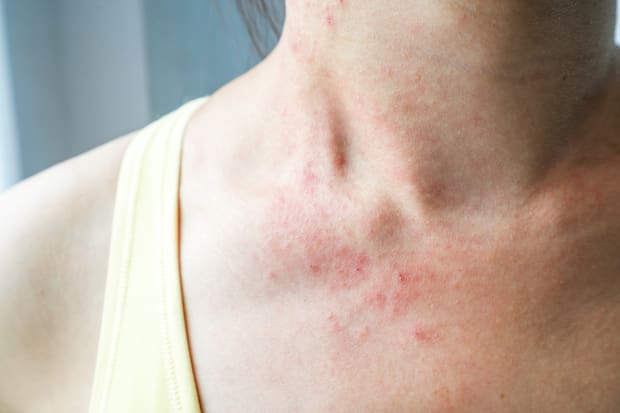Table of Contents
I. What is the Function of Skin?
II. How Common are Skin Problems?
VI. General Diagnosis of Skin Problems
VII. General Treatment and Drug Overview
What is the Function of Skin?
Your skin is your first line of defense against outside bacteria and irritants. The skin is the largest organ in the body and serves many important functions. The skin regulates the body temperature, maintains your water and electrolyte balance, and helps you feel painful and pleasant stimuli. [1] Your skin also participates in a vital process called vitamin D synthesis. When sunlight hits your skin, your skin turns cholesterol into vitamin D. Without this process, you are at a higher risk of developing cancer, depression, muscle weakness, and osteoporosis (bone disease). [2]
Your skin keeps helpful nutrients inside the body and the harmful matter out, protecting you from things like ultraviolet radiation from the sun. Finally, the color and texture of your skin determine your appearance. [1]
The functions of your skin can be disrupted by several factors. Common skin problems like acne, psoriasis, and rosacea are generally treated with topical creams or gels like Retin A (Tretinoin), Oracea (Doxycycline Delayed Release), Tazorac (Tazarotene), or Aczone (Dapsone). Occasionally, skin problems can indicate a disorder that is affecting another part of your body. When diagnosing a skin problem, your doctor may conduct tests to see if your skin problem is a symptom of another disorder. [1]
How Common are Skin Problems?
Some skin problems are temporary, while others can last for longer periods of time. Since there are hundreds of skin conditions that can affect humans, skin problems are considered common. The development of skin conditions depends on individual factors like age, health, and lifestyle. The most common temporary skin conditions include:
- Acne: pimples and pus
- Hives: itchy skin
- Warts: raised bumps on the skin
- Candidiasis: overgrowth of fungus
- Cold sore: fluid-filled blisters
- Fungal nail infection: the buildup of fungus that causes scaling and flaking
- Athlete’s foot: fungus-induced rash [3]

Long-term skin conditions may include:
- Seborrheic dermatitis: also known as cradle cap in babies, involves greasy and scaly patches on the scalp
- Moles: skin cells that bunch up and cause growths on the skin
- Melanoma: abnormal moles that indicate skin cancer
- Rosacea: redness on the skin
- Lupus: attacks the immune system and causes red patches on the skin
- Psoriasis: an autoimmune disorder that leads to abnormal skin irritation
- Eczema: extremely itchy rashes
- Vitiligo: loss of pigmentation in the skin [3]
Understanding Acne
Acne is the most widespread skin problem out of all the conditions listed above. Acne occurs when dead skin cells, oil, and bacteria accumulate in your hair follicles (the structure from which the hair grows). This can cause pimples, blackheads, and whiteheads. Mild acne can disappear on its own, but severe acne may leave scars on the skin. [4]
Because acne is caused by bacteria, excess oil production, clogged hair follicles, and inflammation, symptoms usually appear in areas of the skin that have the most oil glands. When a hair follicle is plugged, the follicle wall may bulge, forming a whitehead. If this bulge is open, air exposure will cause it to darken into a blackhead. When this bulge is inflamed, it will turn red and cause a pimple. [4]
Hormonal changes may also trigger acne. Teenagers are often seen with acne because androgens (a hormone that increases during puberty) cause the sebaceous glands (small glands in the skin) to enlarge. Medications that contain corticosteroids, testosterone, or lithium may trigger acne as well. Some studies show that carbohydrate-rich foods and stress may make your acne worse. [4]

Understanding Psoriasis
Psoriasis is characterized by bumpy red patches covered with white scales. This skin disorder causes skin cells to multiply up to 10 times faster than usual. Psoriasis can appear anywhere, but it usually occurs on the scalp, elbow, knee, or lower back. Around 10 to 30 percent of people with psoriasis experience a complication that leads to pain and swelling in the joints (psoriatic arthritis). [5]
There are six types of psoriasis: plaque, pustular, guttate, inverse, and erythrodermic. Plaque psoriasis is the most common type. Plaque psoriasis can cause symptoms that include:
- Painful and itchy plaques of red skin and silver scales that can crack and bleed
- Discoloration or detachment of fingernails and toenails
- Plaques of scales on the scalp [5]
Different types of psoriasis may be triggered by different things. For example, guttate psoriasis may be irritated by respiratory infections, strep throat, or tonsillitis (inflammation of the tonsils). Erythrodermic psoriasis may be triggered by sunburn, infections, or certain medications. Early diagnosis of psoriasis is important to prevent severe complications. [5]
Understanding Rosacea
Rosacea is a skin condition more common in women than men, but it can affect anyone. The redness of rosacea is caused by visible blood vessels in your face. Rosacea may also cause bumps that look like pimples. Rosacea bumps differ from pimples in that they cause your skin to feel hot and tender. Other symptoms of rosacea include irritated or swollen eyes and an enlarged nose. [6]
Hot drinks and spicy foods are a known trigger of rosacea. Some other factors that can trigger rosacea include alcoholic beverages, extreme temperatures, sunlight, wind, and mood swings. Cosmetic products may worsen the symptoms of rosacea. Some blood pressure medications can trigger rosacea as well. Although the exact cause of rosacea is unclear, we know that rosacea is not caused by poor hygiene. [6]

Smoking can increase your risk of developing rosacea. Having someone in your family with rosacea makes you more likely to get the condition as well. Rosacea can lead to complications like rhinophyma, characterized by an enlarged nose and cheeks. Rhinophyma is the result of tissue buildup over time. Although rosacea is seen more often in women, rhinophyma is more common in men. [6]
General Diagnosis of Skin Problems
Your doctor or a dermatologist (a doctor that specializes in skin conditions) should be your first stop if you encounter a skin problem. Different skin conditions often display similar symptoms, so it is important to confirm the condition that you have before you proceed with any home remedies or medications. [3] To diagnose your skin disease, your doctor will likely order blood tests to rule out any underlying conditions. [1]
General Treatment and Drug Overview
After your doctor confirms that your skin condition is not a symptom of another health problem, you will generally be prescribed topical creams to treat your symptoms. Retin A (Tretinoin) and Aczone (Dapsone) come in a gel form and are usually prescribed for acne. Psoriasis is generally treated with a cream called Tazorac (Tazarotene). Rosacea symptoms can be treated with Oracea (Doxycycline Delayed Release). Early treatment of your skin condition is the best way to prevent complications to your health or scarring on your face and body.
The content provided in this article is based on thorough research and in some cases, reviewed by a medical professional. Our goal for the information is to provide helpful, general health informational. It is not intended as a substitute for professional medical advice.
